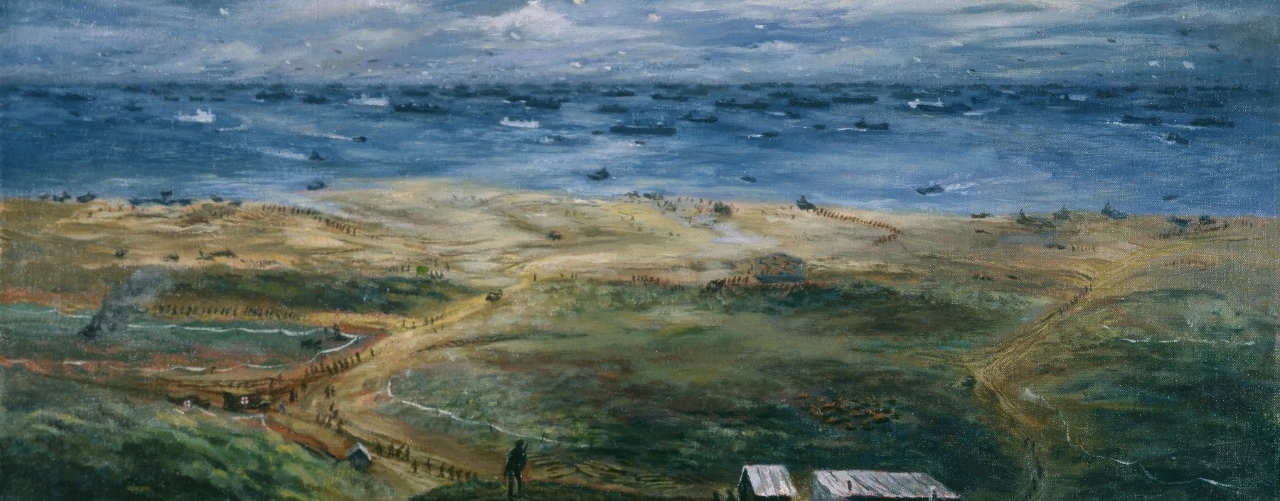
Alexander Russo
Alexander Russo was born in 1922 in Atlantic City, New Jersey. He attended high school there and upon graduating went to Brooklyn, New York, where he studied art at the Pratt Institute.
In October 1942, he enlisted in the United States Naval Reserve as an apprentice seaman. Russo was sent to the Great Lakes Naval Training Station for “Boot Camp,” and while there, he painted a mural for one of the Regimental Headquarters. His talent was spotted, and from that moment forward, Russo’s Navy career was as a Navy artist. He was transferred to the U.S. Navy Recruiting Bureau in White Plains, New York, where he started illustrating literature for Navy training and recruiting programs.
It was not long, however, before Russo was assigned duty with the Amphibious Force, Atlantic Fleet. He had requested an assignment that was “more exciting.” In January 1943, he began working in a Reproduction Unit, a branch of Naval Intelligence. His duties were to make shoreline sketches for use by the assault forces. Together with three other enlisted men from his unit, he was assigned to a Task Force that participated in the initial landings on Sicily.
During the assault on Sicily, Russo was assigned temporary additional duty aboard the U.S.S. Susan B. Anthony, upon personal request, in order to get a better and closer view of the night bombardment. Sketches made shortly afterward were reproduced in Lieutenant John Mason Brown’s book, “To All Hands.” Upon return to his base at Camp Bradford, Virginia, Russo was given time to complete work on paintings based on the invasion.
In November 1943, Russo went to London, England with a U.S. Naval Task Force. During his spare time he sketched London life with its blackouts and other realities of war. Very few large paintings were attempted during this time owing to the regularity of enemy air raids. Although assigned to a Map Reproduction unit, Rear Echelon, Russo volunteered for an active assignment to make a graphic report on the Normandy Invasion. He sketched loading activity at the ports of Weymouth and Plymouth before going aboard an LST on D-Day, reaching the shores of France on D-Day plus 2. There he sketched beach activity and unloading problems. He also made sketches of the ruins of Verville-Sur-Mer and Colleville-Sur-Mer. Russo later used these sketches as the basis for finished paintings.
In April 1945, Russo was selected to execute a series of paintings for the Bureau of Medicine and Surgery, Navy Department. He spent five months aboard the hospital ship U.S.S. Tranquility in the Pacific Theater, sketching the evacuation of casualties and survivors from advance base hospitals and combatant ships to Tranquility.
The Navy Art Collection contains 84 works from World War II by Russo, most of them watercolor or gouache.
After the war, Russo made his living as an artist and art teacher. He received two Guggenheim Fellowships, one in 1947 and the other in 1949. He exhibited in numerous solo and group exhibitions, mainly in New York and Washington, D.C. From 1961 to 1969 he taught at the Corcoran School of Art in Washington, D.C.
In 1964, Russo was invited to participate in the unclassified activities of the Sixth Fleet aboard the U.S.S. Enterprise (CVA-65) in order to paint a new series of works for the Navy. The month he spent with Enterprise and her crew resulted in 28 additional works for the Navy Art Collection: three finished paintings and twenty-five sketches.
From 1970 until his retirement in 1990, Russo taught at Hood College in Frederick, Maryland. He continued to have his work collected and exhibited widely. In 1991, the Bell Gallery of Seattle, Washington produced a retrospective exhibition of his life's work.


